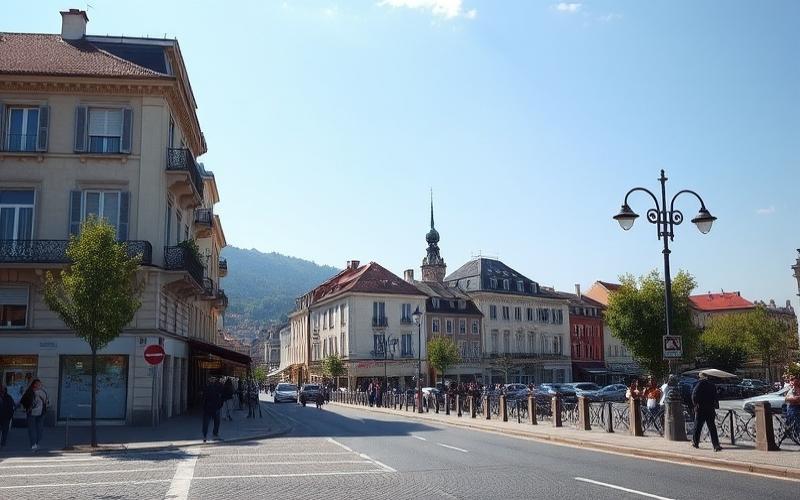
 Published on and written by Cyril Jarnias
Published on and written by Cyril Jarnias
In a country known for its high standard of living, many are seeking alternatives to reduce expenses without sacrificing quality of life. Micro-apartments are emerging in Switzerland as an innovative solution, allowing urban residents to enjoy prime locations at more accessible costs. These compact dwellings, often cleverly designed, offer an ingenious response to intense urbanization challenges while aligning with the enthusiasm for ecological sustainability. But as real estate pressure intensifies, are these reduced spaces truly an effective solution for tight budgets or merely a compromise in the face of an inescapable economic reality?
Studio Investment in Switzerland: Why Choose Micro-Apartments
Economic Benefits of Micro-Apartments in Switzerland
- Reduced Purchase Cost: Micro-apartments, typically ranging from 20 to 45 m², feature a significantly lower acquisition price than traditional apartments. This compactness reduces the initial investment while facilitating access to the real estate market in urban areas where prices have doubled over the past two decades.
- Lower Maintenance Fees: The small area naturally implies fewer expenses for routine maintenance, heating, or shared charges. According to several recent analyses, the total cost (purchase + maintenance) is 25 to 30% lower compared to conventional housing.
Profitability Potential and Strong Rental Demand
- Higher Profitability per Square Meter: Monthly rents for micro-apartments are higher per square meter than for standard housing. For example:
| Layout Type | Total Monthly Rent | Rent/m² |
| 2 x 50 m² = 100 m² | CHF 5,200 | CHF 52 |
| 5 x 20 m² = 100 m² (micro) | CHF 6,000 | CHF 60 |
This differential is explained by very strong urban demand and an extremely low vacancy rate (0.7% in Geneva at the start of the year), ensuring quick and continuous rental.
- Portfolio Diversification: Dividing into multiple units increases resilience against rental risks; a vacancy has a lesser impact on overall profitability.
Growing Appeal Among Young Professionals and Students
- Economic Accessibility: Faced with continuously rising rents (+3.25% expected by end 2025), these dwellings often represent the only affordable solution for young professionals or students seeking to live near downtown.
- Modern Urban Lifestyle: Shared amenities (communal laundry, coworking spaces) combined with smart technologies particularly appeal to this dynamic demographic.
Swiss Market Trends Favoring Compact Housing
- Increased Urbanization: Major cities like Zurich, Geneva, or Lausanne are seeing their young population grow rapidly while the real estate supply remains constrained. Several Swiss cantons actively encourage the construction of micro-housing through tax or regulatory incentives.
- Residential Innovation: The massive development of “micro-living” concepts integrating home automation and energy-efficient solutions aligns with sustainable logic, meeting both current environmental and economic needs.
Particularly Advantageous Cities for Investing in Micro-Apartments
| City | Vacancy Rate (%) | Average Purchase Price/m²* | Main Target Population |
| Geneva | ~0.7 | > CHF 13,000 | Young International Professionals |
| Lausanne | CHF 10,500 | Students & Startuppers | |
| Zurich | CHF 14,500 | Consultants & Tech/Finance Expatriates |
*Average figures early/mid-2025 according to latest trends
In summary, opting for a micro-studio apartment not only provides more accessible entry into the Swiss real estate market but also guarantees high returns due to sustained urban demand—all within a context where residential flexibility and sustainability are becoming central to contemporary living.
Good to Know:
Investing in micro-apartments in Switzerland offers several economic advantages, including reduced purchase and maintenance costs compared to traditional housing. With generally lower prices per square meter and lower fees, these studios are attractive to investors seeking increased profitability. The urban rental market in Switzerland is marked by strong demand, particularly in major cities like Zurich and Geneva, where young professionals and students increasingly favor compact housing for its affordability. According to the latest statistics, in 2023, the vacancy rate for small units was barely 1.2% in urban centers, indicating high rental potential. This trend is supported by a real estate market leaning towards efficient and flexible housing solutions, responding to growing mobility and financial accessibility needs.
Microliving: A Booming Trend in Switzerland
The rise of microliving in Switzerland is primarily explained by the sharp increase in the cost of living, particularly rents, as well as demographic and social changes altering housing expectations. Faced with a persistent housing shortage and continuously rising prices—rents showing annual growth of about 4% and housing prices having increased by nearly 5% over one year—microliving appears as an economical and pragmatic solution for a growing number of individuals.
Table: Recent Evolution of the Swiss Real Estate Market
| Indicator | Variation (2024-2025) |
|---|---|
| Average Rental Prices | +4% |
| Average Purchase Prices | +4.8% |
| Total Population (end 2024) | 9 million |
| Population Forecast (2055) | 10.5 million |
| New Housing Units Expected (from 2025) | +39,000 units |
Micro-apartments are clearly gaining popularity. It is observed that each new residential project includes on average 22% more units than before, indicating a trend towards reducing the average size of housing offered on the market.
Economic Benefits of Microliving
- Significant reduction in monthly rent due to small square footage.
- Notable decrease in ancillary costs: heating, electricity, and routine maintenance.
- Lower initial investment for furnishing or equipment.
- Increased flexibility to meet temporary or mobile needs.
Target Audiences
Microliving particularly meets the expectations of:
- Young professionals attracted to urban centers where conventional supply is scarce or unaffordable.
- Students seeking proximity to universities or economic hubs while controlling their budget.
- Single individuals enjoying solutions combining minimal privacy and optional community living.
Social Changes Favoring Microliving
The rapid increase in single-person households—a trend expected to intensify in the coming years—reinforces this phenomenon. The growing importance placed on professional mobility and a flexible lifestyle also encourages this evolution.
List: Societal Factors Accelerating Microliving
- Sustained urbanization
- Increased individualization
- Enhanced professional mobility
- Active pursuit of savings in the face of high overall costs
Challenges Associated with Microliving
Despite its advantages, the model presents several constraints:
- Limited personal space potentially restricting comfort and privacy.
- Frequent need for shared spaces (communal laundry, collective kitchen), a potential source of conflicts or logistical complexity.
- Potential difficulty in personalizing one’s living environment according to specific needs.
Future Prospects
With a population expected around 10.5 million in Switzerland by 2055, while construction still sometimes struggles to keep up with this rapid demographic growth, it is likely that the micro-apartment market will continue its upward momentum. Forecasts suggest not only a continuation but also a gradual intensification considering:
- The structural shift towards more single-person households,
- The expected persistence of inflationary pressures on real estate prices,
- And finally: The continuous adaptation of real estate developers increasingly offering this type of compact housing in their new residential projects.
Good to Know:
Microliving, a growing trend in Switzerland, is propelled by the high cost of living, pushing young professionals and students towards affordable solutions like micro-apartments. In 2022, over 15% of new housing in Switzerland were micro-apartments, illustrating their popularity. This type of housing reduces rental and maintenance costs while maximizing space efficiency, ideal for those looking to save while living close to urban centers. However, the challenge lies in limited spaces and the necessity of cohabitation, requiring social adaptation. The future of microliving appears promising, with economic projections indicating growing demand, supported by young and urban demographics seeking flexible and economical housing.
Returns and Benefits of Small Spaces in 2025
Micro-apartments are experiencing growing popularity in the Swiss real estate market in 2025, driven by sustained demand in urban centers and societal changes favoring small spaces. The average price of an apartment in French-speaking Switzerland now reaches CHF 13,886/m² in Geneva and CHF 10,164/m² in the canton of Vaud, with an increase of over 90% in two decades for this type of property. This price tension, combined with population growth (+81,000 people expected in 2025), enhances interest in compact housing suitable for young professionals and students.
Main Advantages of Micro-Apartments:
- Easier access to housing in central areas where supply is scarce
- More affordable rents than large apartments
- Significant reduction in rental charges (heating, maintenance)
- Better energy efficiency: reduced area = less energy consumed
| Criterion | Micro-Apartment | Traditional Apartment |
| Average Area | 50 m² | |
| Monthly Rent (estimate) | CHF 1,100–1,600 | CHF 2,200–3,500 |
| Annual Charges | Low | High |
| Energy Consumption | Very Low | Medium to High |
Economic Trends Favoring These Spaces:
- Continuous rise in housing costs (+4.4% for apartments in Q1 2025)
- Increase in search subscriptions for this segment (+20% in one year)
- Flexibility sought by a mobile and connected urban population
- Scarcity of available land in major cities
Micro-Housing Also Offers a More Sustainable Model:
- Less space to heat or cool
- Less furniture needed, thus reducing material consumption
- Promotes the use of soft mobility due to central location
Innovative Technologies and Interior Layouts:
- Multifunctional retractable furniture (wall beds, extendable tables)
- Home automation solutions to optimize lighting/heating based on actual presence
- Shared communal spaces: laundry facilities, integrated coworking
Positive Impact on Modern Urban Lifestyle:
Small spaces encourage voluntary simplicity while providing privileged access to cultural, professional, or sports infrastructure offered by the city.
Incentive Local Policies:
- Localized relaxation of minimum habitable area standards
- Tax incentives or direct subsidies for projects targeting compact housing
- Planned development around stations/soft mobility to integrate these new dwellings without further congesting the existing urban fabric
Challenges Associated with Urban Densification:
- Increased risk of social anonymity if no mix or collective space is planned
- Heightened pressure on certain public infrastructures (local transport)
- Absolute necessity for good sound insulation/architectural quality
In summary, micro-apartments are establishing themselves as a pragmatic response to economic and ecological constraints while profoundly renewing the urban lifestyle.
Good to Know:
In 2025, the Swiss real estate market sees growing popularity of micro-apartments, with an occupancy rate nearing 90% in urban areas, thanks to their appeal to young professionals and students seeking affordable housing. The reduced cost of living, resulting from minimized charges and energy needs, makes them an attractive option, particularly in an economic context marked by high real estate prices. Technological advancements optimize these spaces with modular furniture and connected solutions, making urban living more sustainable. Moreover, local public policies, such as incentive subsidies, support the development of these habitats, although urban densification continues to pose logistical challenges. These small spaces not only favor an economical and ecological life but actively transform the urban landscape in Switzerland, promoting a modern and intelligent lifestyle.
Disclaimer: The information provided on this website is for informational purposes only and does not constitute financial, legal, or professional advice. We encourage you to consult qualified experts before making any investment, real estate, or expatriation decisions. Although we strive to maintain up-to-date and accurate information, we do not guarantee the completeness, accuracy, or timeliness of the proposed content. As investment and expatriation involve risks, we disclaim any liability for potential losses or damages arising from the use of this site. Your use of this site confirms your acceptance of these terms and your understanding of the associated risks.

















































